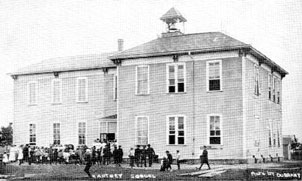|
THE
TEACHER IN THE HARTNEY SCHOOL with the longest tenure was Miss Blanche
Hunter, who came to the town with her family when her father bought the
Butchart hardware store in 1894. From that time until 1916 she taught
the primary room and was a profound influence for good manners and
discipline on all the grades of the school.
Blanche Hunter had a slight, erect figure of average height, and oval
face with fine eyes and beautifully arched eyebrows. She could express
approval or pleasure with a slow smile or her displeasure by a
straightening of her firm lips. Her hair was beautifully arranged high
on her head and this arrangement added dignity to her appearance. But
Blanche Hunter needed not high-piled hair to give her dignity. Dignity
was the essence of her being and it impressed her pupils while they
were in her classes, and for all their lives.
She was never an intimate friend to her pupils, but remained a sort of
deity whose approbation they strove with all their childish powers to
win, whose smile was their eagerly sought reward and whose disfavour
made their lives miserable indeed. She made learning easy and she made
her pupils feel that to be ignorant was the worst fate that could
befall them. Her approach was ever positive and sure. The large band of
Hartney folk who look back to their first school days under Miss
Hunter’s supervision are unanimous in acclaiming her a great teacher
and a powerful factor in the creation of what is fine in their lives.
Adapted from The Mere
Living, page 121.
A Day
in the Life of a Teacher
A teacher’s duties in the late 1800s and early 1900s were many, varied
and difficult. Many teachers walked a mile or more to work every
morning, and home in the evening through farmer’s fields, herds of
cows, rainstorms, or blizzards. Some had the luxury of riding horses
for lengthy distances.
Upon arrival at school, the new teacher drew pails of drinking and
washing water from the well, then set them up just inside the front
door of the school. If it was a cold morning she would gather wood from
the woodpile and start a fire. If it was hot she would see to it to
open the windows and door. She might sweep the floor and wipe off the
rough-hewn plank chairs and desks. She would check to make sure the
“privies” or outhouses were tidy and sanitary, and make sure that her
black-laquered plywood blackboard was washed.
Next, she dealt with the arrival of her students, many of them immature
and ignorant. The male students could be much larger than she, and even
older in years—and some resented being there at all, away from farm
work. There could be jeers and jibes, truancy, and general
disobedience. Many 19th-century female teachers complained that
teaching was especially hard when “big boys” flirted, teased or defied
them.
The curriculum usually included reading, writing, basic arithmetic, a
little geography and history. Books were scarce and teaching tools few.
The texts often took the form of moral tracts or primers of childish
virtues and sometimes children were even asked to bring whatever books
were at home, such as an almanac or old textbooks.
The blackboard proved essential as she printed and wrote lessons while
students copied notes onto slates. Most students had to furnish their
own supplies including writing slates and chalk. It would be some years
before scribblers and pencils came into use, and only when there was
money to buy them. In rural schoolhouses, apart from overcrowding,
practical solutions had to be sought to overcome darkness and poor
ventilation.

Hartney School, built in 1892 and replaced in 1954.
|





